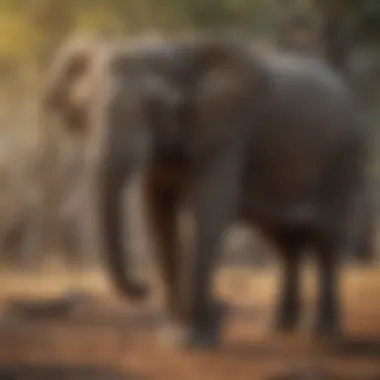Unveiling the Intriguing Average Weight Variations Among Elephant Species


Animal Species Profile
Elephants are a remarkable species that captivates researchers and animal enthusiasts alike with their sheer size and gentle demeanor. These majestic creatures are characterized by their large bodies, long, curved tusks, and distinct floppy ears. Found primarily in savannas, forests, and grasslands across Africa and Asia, elephants are known for their complex social structures and strong family bonds.
Physical characteristics and appearance
Elephants are the largest land animals on Earth, with the African elephants being bigger than their Asian counterparts. African elephants can reach up to 13 feet in height and weigh between 5,000 to 14,000 pounds, while Asian elephants can grow up to 10 feet in height and weigh between 4,500 to 12,000 pounds. Their tusks are elongated incisor teeth used for various purposes, including digging for water, stripping bark, and defending against predators.
Natural habitat and distribution
Elephants thrive in a variety of habitats, from dense rainforests to open grasslands. African elephants are mainly found in sub-Saharan Africa, with populations in countries like Kenya, Tanzania, and Botswana. Asian elephants, on the other hand, inhabit countries like India, Thailand, and Indonesia. Habitat loss and poaching have significantly impacted elephant populations worldwide, leading to conservation concerns.
Behavior and social interactions
Elephants exhibit highly sophisticated social behaviors, living in tight-knit family groups led by matriarchs. These groups communicate through a complex system of vocalizations, body language, and infrasound. Elephants display empathy, grief, and altruism, often forming deep emotional bonds within their herds. Their social interactions are crucial for survival, as they rely on each other for protection, foraging, and raising young calves.
Introduction
Diving into the captivating realm of elephant biology, this article embarks on a profound investigation into the average weight of elephants, a topic of immense significance in understanding these majestic creatures. Elephant weight is not merely a number on a scale; it embodies essential insights crucial for conservation efforts and maintaining ecological balance. By unraveling the intricate details surrounding elephant weight, we uncover a treasure trove of knowledge that sheds light on the very foundation of these magnificent beings.
Brief Overview of Elephants
Overview of Elephant Physiology
An integral aspect in comprehending elephants is to delve into their remarkable physiology. The physiognomy of elephants is a marvel of nature, characterized by their immense size, robust stature, and unique adaptations. Their physiology, from the sheer strength exhibited through their muscular structure to the iconic elongated trunk, plays a pivotal role in their survival and behavior. Understanding the nuances of elephant physiology provides a gateway to appreciating their evolutionary journey and the biological marvels they exhibit. Through a thorough exploration of elephant anatomy and physiology, we can grasp the intrinsic connection between their physical traits and survival strategies, offering profound insights into their existence.
Importance of Understanding Elephant Weight


In the mosaic of elephant biology, weight stands as a cornerstone element with profound implications. The importance of comprehending elephant weight transcends mere numbers; it unravels a tapestry of knowledge vital for shaping conservation strategies and ecological management. By discerning the weight variations among different elephant species, researchers can tailor conservation efforts to suit the specific needs of these magnificent creatures. Elephant weight serves as a compass guiding conservationists towards effective measures to ensure the well-being of these animals and the sustainability of their habitats. Delving into the significance of understanding elephant weight unveils a deeper appreciation for the delicate balance in the natural world and underscores the imperative of conserving these gentle giants of the animal kingdom.
Factors Influencing Elephant Weight
Explaining the importance of the topic Factors Influencing Elephant Weight within this article holds significant weight in shedding light on the complexity behind understanding elephant weight variations. By delving into factors such as species variation, age, sexual dimorphism, and nutritional aspects, a comprehensive view on how different elements play a crucial role in an elephant's weight can be obtained. Appreciating these details not only enhances our understanding of elephant biology but also emphasizes the necessity of considering these factors in conservation efforts and ecological balance.
Species Variation
African Elephants
When discussing African Elephants, it becomes apparent that these majestic creatures possess remarkable physical attributes that contribute significantly to our exploration of elephant weight. Their massive size, characterized by broad ears and tusks, distinguishes them from other elephant species. African Elephants are often featured prominently in discussions surrounding elephant weight due to their prominence in the wild and the sheer impact their weight has on their habitat.
Asian Elephants
Asian Elephants provide a contrasting perspective on elephant weight, showcasing a different set of features that are equally essential to our investigation. The distinctive characteristics of Asian Elephants, such as their smaller ears and smoother skin, offer a unique angle in understanding weight variations among elephant species. Exploring Asian Elephants' contribution to the overall topic not only enriches our knowledge but also emphasizes the diversity present in the elephant kingdom.
Dwarf Elephants
Dwarf Elephants introduce a fascinating element to the discourse on elephant weight, presenting a less commonly discussed yet intriguing aspect of these gentle giants. Their smaller stature and proportionally sized features make them a compelling subject within this article. Examining the unique features of Dwarf Elephants sheds light on the adaptive nature of elephants across different environments and provides an insightful contrast to larger elephant species.
Age and Growth Rate
Impact of Age on Elephant Weight
The impact of age on elephant weight offers a comprehensive insight into how the developmental stages of these animals influence their overall mass. Understanding how age affects weight not only underscores the importance of considering elephants' growth trajectory but also highlights the physiological changes that occur over time. By delving into this aspect, we gain a deeper appreciation for the nuanced relationship between age and weight in elephants.
Growth Patterns in Elephants


Exploring the growth patterns in elephants unveils a captivating narrative of how these magnificent creatures evolve from infancy to adulthood. Analyzing the patterns of growth presents a dynamic view of elephant weight fluctuations throughout their life cycle. Highlighting the factors that shape their growth not only enriches our understanding of elephant biology but also emphasizes the intricacies involved in studying elephant weight variations.
Sexual Dimorphism
Differences in Weight Between Male and Female Elephants
Understanding the differences in weight between male and female elephants unveils an intriguing dimension in the narrative of elephant weight variations. By examining the disparities in weight, we gain valuable insights into the biological differences between male and female elephants. Delving into this aspect not only enhances our understanding of sexual dimorphism among elephants but also underscores the significance of considering gender-specific weight metrics in research and conservation efforts.
Factors Contributing to Sexual Dimorphism
Analyzing the factors contributing to sexual dimorphism sheds light on the underlying mechanisms that shape weight variations between male and female elephants. By identifying the key factors that influence these differences, we develop a more nuanced understanding of how genetic, hormonal, and ecological elements intersect to create distinct weight patterns. Exploring this aspect adds a layer of complexity to our exploration of elephant weight and offers valuable insights into the broader implications of sexual dimorphism.
Nutritional Factors
Dietary Habits and Weight
Examining the interplay between dietary habits and weight illuminates a critical aspect of elephant biology that directly influences their overall mass. Understanding how elephants' dietary preferences impact their weight not only highlights the importance of a well-balanced diet but also underscores the role of nutrition in maintaining optimal body condition. By delving into this aspect, we garner a deeper appreciation for the intricate relationship between nutritional factors and elephant weight.
Impact of Habitat on Nutritional Intake
Exploring the impact of habitat on nutritional intake unveils a compelling perspective on how environmental factors shape elephants' dietary resources. Analyzing how the habitat influences nutritional intake elucidates the ecological dynamics that contribute to weight variations among elephant populations. By investigating this aspect, we not only deepen our understanding of the intricate relationship between elephants and their environment but also underscore the importance of habitat conservation in ensuring the well-being of these magnificent animals.
Significance of Elephant Weight
In the vast realm of animal biology, the weight of an elephant carries immense significance. Understanding the significance of elephant weight is paramount in unraveling the intricate web of conservation efforts and ecological balance. By delving into the weight variations among different elephant species, researchers gain valuable insights that can shape strategies for the protection and sustainable management of these majestic creatures. Elephant weight plays a critical role in determining their overall health, lifespan, reproductive success, and interactions within their habitats. It serves as a key indicator of the well-being of individual elephants and the broader population trends. Furthermore, by comprehending the factors influencing elephant weight, such as species variation, age, nutritional habits, and sexual dimorphism, scientists can craft informed decisions to ensure the long-term survival of elephant populations.
Ecological Importance


Role of Elephant Weight in Ecosystem Dynamics
Investigating the role of elephant weight in ecosystem dynamics unveils a fundamental aspect of the intricate tapestry of natural interactions. The weight of elephants directly influences their foraging patterns, movement behaviors, and social dynamics, which, in turn, cascade through the ecosystem. Elephants, as megaherbivores, exert significant pressure on vegetation through grazing and browsing, shaping plant communities and driving habitat modifications. Their weight impacts soil compaction, seed dispersal, and nutrient cycling, influencing the abundance and distribution of plant species. Understanding the intricate balance between elephant weight and ecosystem dynamics is essential for safeguarding biodiversity, preserving ecosystem functions, and promoting sustainable coexistence between wildlife and their habitats.
Implications for Plant Communities
Exploring the implications of elephant weight for plant communities sheds light on the intricate relationships between herbivores and vegetation. As elephants traverse vast landscapes in search of food and water, their weight determines the extent of vegetation impact and regeneration. By selectively feeding on certain plant species, elephants shape the composition and structure of plant communities, driving ecological succession and biodiversity patterns. The trampling effects of elephants on vegetation create microhabitats for other species, influencing the overall plant diversity and ecosystem resilience. Recognizing the implications of elephant weight for plant communities is crucial for aligning conservation strategies with the dynamic interplay between herbivores and their botanical surroundings.
Conservation Implications
Elephants, these gentle giants of the animal kingdom, carry more weight in the ecological balance than their massive bodies portray. The conservation implications of elephant weight extend far beyond their individual size, reverberating through entire ecosystems. Understanding the impact of their weight variations is paramount for designing effective conservation strategies that can safeguard not just the elephants but also the intricate web of life they are a part of. By delving into the nuances of elephant weight, conservationists can tailor their efforts to preserve these majestic creatures and the habitats they inhabit, ensuring a harmonious coexistence between wildlife and human activities.
Impact on Conservation Strategies
Conservation Efforts Based on Elephant Weight Data
Digging deeper into the realm of conservation strategies, the utilization of elephant weight data proves to be a pivotal tool. This specific aspect of conservation efforts involves meticulous data collection and analysis, focusing on the weight patterns of elephant populations to inform targeted conservation interventions. By harnessing the insights derived from elephant weight data, conservationists can identify key trends, monitor the health of elephant communities, and adapt their strategies to address emerging threats effectively. The precision offered by such data-driven initiatives enhances the efficiency of conservation programs, allowing for the allocation of resources where they are most needed. Despite its technical nature, Conservation Efforts Based on Elephant Weight Data stands as a beacon of hope in the conservation landscape, providing concrete data to guide impactful interventions.
Threats to Different Elephant Species
On the other side of the coin lie the ominous shadows of threats looming over different elephant species. This facet of conservation sheds light on the multitude of challenges facing elephants in various habitats, from poaching and habitat loss to human-wildlife conflicts. Understanding the specific threats to different elephant species is crucial for formulating targeted conservation measures that address these pressing issues head-on. By unpacking the unique risks faced by various elephant populations, conservationists can tailor their strategies to mitigate these threats effectively, ensuring the long-term survival of these iconic animals. Despite the daunting nature of these challenges, recognizing the Threats to Different Elephant Species is the first step towards implementing comprehensive conservation strategies that protect these magnificent creatures for generations to come.
Conclusion
Key Takeaways
Understanding the Weight Variations Among Elephants
Delving into the intricacies of weight variations among elephants sheds light on the nuanced factors shaping the physiques of these colossal mammals. The exploration of how species differences, age, gender, and dietary habits interplay to determine elephant weight offers a comprehensive understanding of these majestic beings' biology. Understanding these weight variations is central to devising effective conservation strategies and ensuring the long-term well-being of elephant populations.
Implications for Elephant Conservation
The implications of elephant weight on conservation efforts are profound, with weight variations serving as crucial indicators of the health and sustainability of elephant ecosystems. By elucidating how shifts in weight can reflect environmental changes and human impacts, we unveil valuable insights into the intricate relationship between elephant conservation and ecosystem dynamics. Understanding the implications of weight fluctuations equips conservationists and policymakers with the knowledge needed to implement targeted measures to safeguard elephant populations and their habitats.







